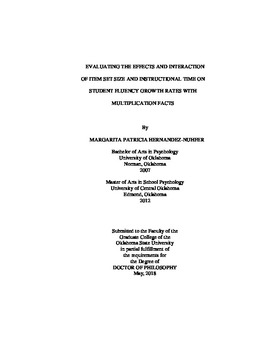| dc.contributor.advisor | Poncy, Brian C. | |
| dc.contributor.author | Hernandez-Nuhfer, Margarita Patricia | |
| dc.date.accessioned | 2018-12-11T22:09:45Z | |
| dc.date.available | 2018-12-11T22:09:45Z | |
| dc.date.issued | 2018-05 | |
| dc.identifier.uri | https://hdl.handle.net/11244/316317 | |
| dc.description.abstract | The present study evaluated the effects and interaction of item set size and instructional time on students' fluency growth rates with multiplication facts over time when using an Explicit Timing intervention. The first goal was to determine an interaction between set size and instructional time across time that would influence the fluency growth rate on multiplication facts. A second goal was to determine an optimal combination of set size and instructional time to promote highest fluency growth rate. A third goal was to determine an optimal combination of set size and instructional time to enhance generalization of multiplication facts. A fourth goal was to determine an optimal combination of set size and instructional time to enhance maintenance of multiplication facts over time. A total of 11 fluency measures were taken among 204 fourth grade students from 10 general education classrooms among two public schools in central Oklahoma, who were randomly assigned to one of nine condition groups. Condition groups represented a combination among three levels of set size, defined as the number of multiplication problems, and three levels of instructional time, defined as minutes of instruction per session. Intervention and assessments were given in a class-wide group format. Teachers administered the intervention daily by playing a video, which contained instructions and four 2-minute built-in intervention timed intervals. The total number of digits answered correctly per minute determined fluency performance on each dependent measure (i.e., pre-test, progress monitoring, post-test). Data were analyzed using a 3 x 3 x 8 mixed ANOVA. The between-subjects factors were set size and instructional time, each containing three levels: 9-problems, 18-problems and 36-problems for set size and 2-minutes, 4-minutes and 8-minutes for instructional time. The within- subjects factor was time with eight levels, in the form of progress monitoring assessments (PM1-PM8). Results of the final analysis indicated the absence of a significant three-way interaction between set size, instructional time and time. However, within-subjects effects indicated a significant interaction between time and set size as well as between time and instructional time, indicating that all levels of set size and instructional time performed differently across time. | |
| dc.format | application/pdf | |
| dc.language | en_US | |
| dc.rights | Copyright is held by the author who has granted the Oklahoma State University Library the non-exclusive right to share this material in its institutional repository. Contact Digital Library Services at lib-dls@okstate.edu or 405-744-9161 for the permission policy on the use, reproduction or distribution of this material. | |
| dc.title | Evaluating the effects and interaction of item set size and instructional time on student fluency growth rates with multiplication facts | |
| dc.contributor.committeeMember | Duhon, Gary J. | |
| dc.contributor.committeeMember | Stinnett, Terry A. | |
| dc.contributor.committeeMember | Davis, Robert Evan | |
| osu.filename | HernandezNuhfer_okstate_0664D_15630.pdf | |
| osu.accesstype | Open Access | |
| dc.type.genre | Dissertation | |
| dc.type.material | Text | |
| thesis.degree.discipline | Educational Psychology | |
| thesis.degree.grantor | Oklahoma State University | |
